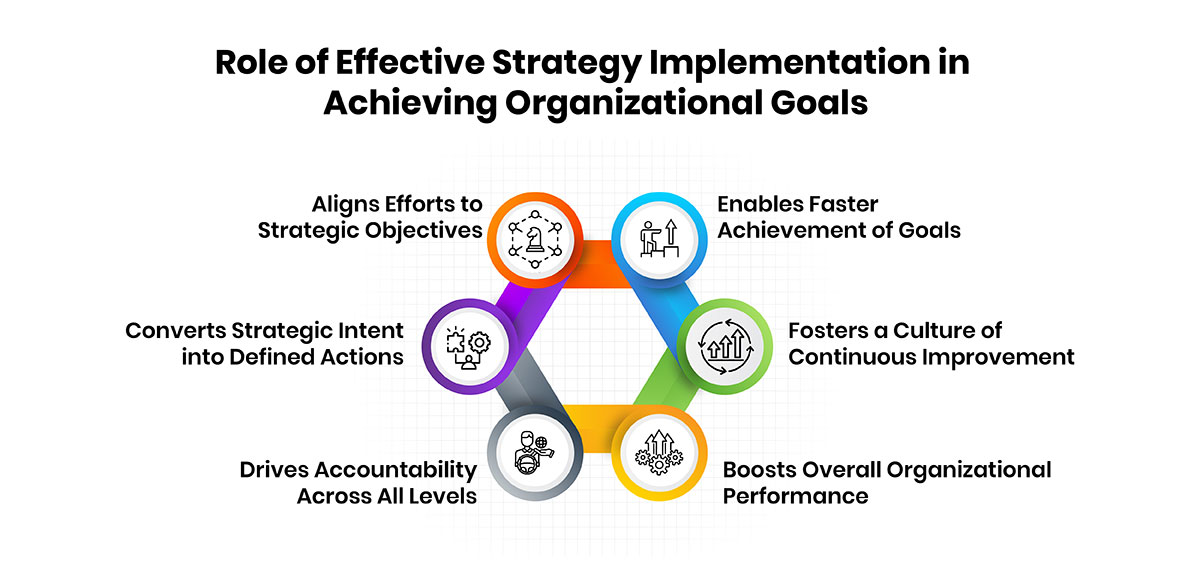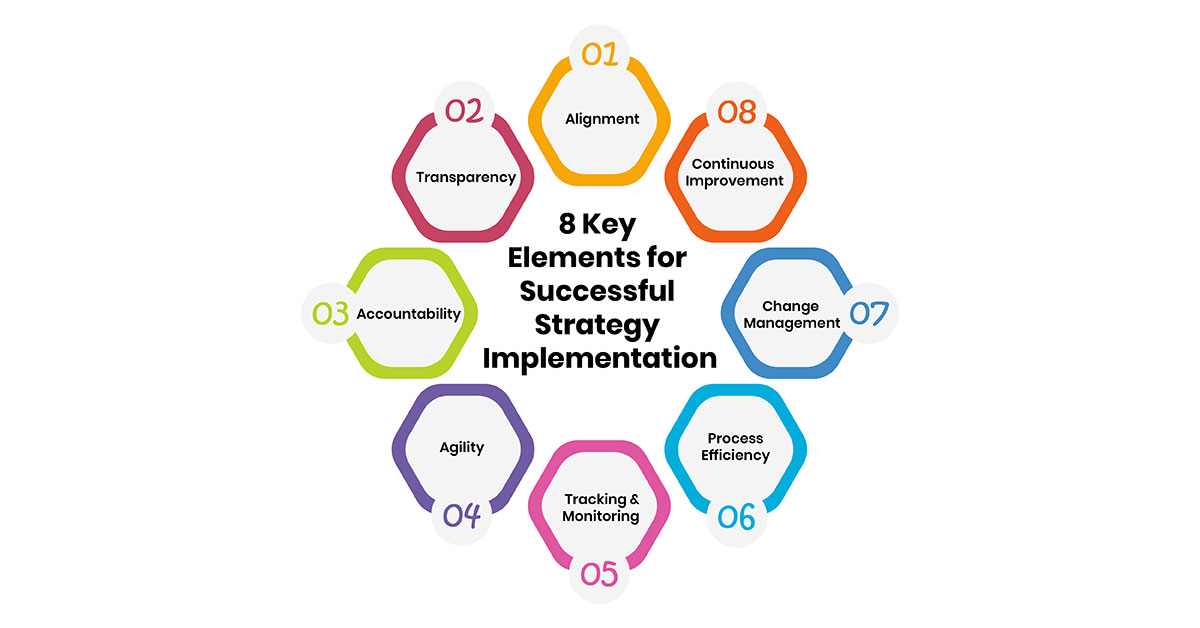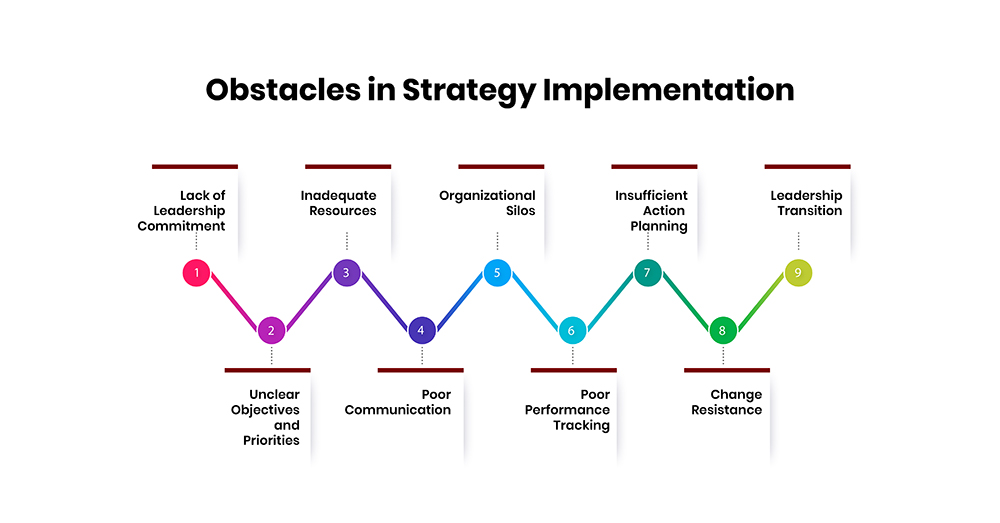Strategy Implementation: Key Concepts for Organizational Success
 January 03, 2025
January 03, 2025
Implementing a robust business strategy is critical for organizations aiming to reach their long-term goals. While creating a strategic plan is important, successful execution is what truly determines an organization's success. Strategy implementation requires aligning all departments, managing resources effectively, and monitoring progress to ensure goals are achieved.
This article covers the key concepts for organizations to master successful strategy execution. By putting these concepts into practice, companies can transform strategic plans into concrete actions, boost performance, and gain a competitive edge.
Role of Effective Strategy Implementation in Achieving Organizational Goals
Effective strategy implementation plays a critical role in helping organizations achieve their strategic goals and objectives. A robust implementation process aligns all departments and teams, ensures efficient allocation and utilization of resources, establishes strong systems to execute plans, and puts in place mechanisms to track progress and adapt when needed.
The key reasons why effective implementation is imperative for achieving organizational goals are:

-
Aligns Efforts to Strategic Objectives
An effective implementation process fosters organization-wide alignment towards the strategic goals and priorities. It ensures that departments across the organization have clarity on the overall objectives and how their plans and activities ladder up to those goals. This alignment of efforts reduces duplication, makes resource utilization more efficient, and brings synergy across teams in driving towards the same end-objectives. Smooth flows of information, effective collaboration platforms, and open communication channels help reinforce enterprise-wide cohesion.
-
Converts Strategic Intent into Defined Actions
Strategy implementation operationalizes the strategic plan and transforms high-level aspirations articulated in the strategy into specific, actionable, and measurable steps that can be executed by employees across levels. The implementation process breaks down broad strategic objectives into tactical goals and milestone markers for individual units and teams. This staged approach of cascading goals along with allocating appropriate resources at each step enables smooth execution of even the most ambitious strategic plans.
-
Drives Accountability Across All Levels
Effective implementation puts in place robust review and performance management mechanisms which creates a culture of accountability across the organizational hierarchy. Progress against implementation plans is continuously monitored through relevant key performance indicators and metrics. Achievement of results is linked to individual goal-sheets as well as departmental success parameters. Regular progress reviews ensure transparency and course-corrections wherever needed. This accountability framework maximizes plan effectiveness.
-
Enables Faster Achievement of Goals
The clarity of objectives, granularity of tactical plans, transparency of monitoring systems and focus on accountabilities significantly accelerates the achievement of strategic goals. Implementation effectiveness plays a huge role in determining the overall strategic planning success. Smooth execution driven by implementation efficiency lets organizations deliver better results faster. Removing obstacles, bolstering capabilities and driving operational excellence thus become critical.
-
Fosters a Culture of Continuous Improvement
The monitoring, control and feedback mechanisms instituted as part of the implementation framework foster an environment of continuous improvements across strategy execution. Tracking progress, assessing performance dynamics, and reiterating implementation priorities based on emerging situations help build an adaptive culture focused on strategy optimization. Learning loops also get embedded organization-wide helping teams innovate solutions to emerging tactical challenges.
-
Boosts Overall Organizational Performance
Smooth strategy execution ensures optimal resource utilization, improved coordination across functions through enhanced information sharing, and higher employee productivity by clarifying roles. Effective implementation also develops execution capabilities organization-wide, maximizes operational efficiencies and strengthens process compliance – collectively translating to significant performance gains. Capability building for strategy alignment also prepares organizations for navigating future disruptions.
Key Elements for Successful Strategy Implementation
For every new strategy developed, these principles pave the way for measurable achievements by guiding the process from strategy formulation to fruitful execution.

-
1. Alignment
Alignment refers to ensuring that all departments, teams, and employees within an organization are working towards the same overarching objectives outlined in the strategic plan. Rather than operating in silos, an aligned organization has a unified vision and understanding of its direction and priorities. Cross-departmental collaboration, open communication channels, and linking team goals to organizational strategy are key to fostering alignment. With staff across the organization striving towards common aims, resources can be utilized more efficiently.
-
2. Transparency
Transparency entails openly communicating details of the strategic plan across all levels of the organization. By ensuring employees understand the objectives, metrics, responsibilities, and timeframes involved, organizations can secure buy-in and cooperation. When staff grasp how their individual roles and departmental objectives contribute to big-picture goals, they are more motivated to do their part. Transparency also enables identification of potential issues or blockers early.
-
3. Accountability
Accountability means clearly defining responsibilities related to the strategy and following through on them. Each strategic objective and initiative must have an owner responsible for ensuring progress and success. With proper accountability enforced, tasks are more likely to be completed on time and milestones reached. Regular check-ins via reports and meetings provide opportunities for stakeholders to demonstrate accountability to their peers.
-
4. Agility
In a volatile market, the ability to rapidly adapt is key. Rigidly adhering to a strategic plan regardless of internal or external changes is a recipe for failure. organizations must continually review performance data, market conditions, and new innovations and be ready to adjust elements of strategy implementation accordingly. Built-in agility to pivot initiatives, shift resources, or update goals based on real-time assessment enables organizations to stay competitive.
-
5. Tracking & Monitoring
The old adage rings true: "what gets measured gets managed." Tracking key metrics aligned to strategic goals is essential for assessing progress. Are initiatives moving the needle on target objectives? Where are there performance gaps? Metrics expose pain points, enabling course correction. Technology solutions help automate tracking and monitoring processes with customizable analytics dashboards.
-
6. Process Efficiency
Well-designed processes turn strategic objectives into executable action plans. Lean, optimized procedures for fulfilling key initiatives prevent wasted resources and friction. Process inefficiencies are roadblocks to successfully implementing strategy across departments. Mapping processes end-to-end, eliminating redundancies, leveraging technology, and regular re-evaluation for enhancements are best practices.
-
7. Change Management
Major strategic changes inevitably cause some uncertainty or resistance, especially when disrupting the status quo. organizations must proactively get ahead of change management, clearly communicating “what’s in it for me” to stakeholders at all levels. Leadership plays a key role in championing changes tied to strategy and rallying staff around a shared vision. Emphasize cross-team collaboration and provide training or transition resources to smooth major shifts.
-
8. Continuous Improvement
Effective implementation fosters a culture of constant enhancement, not just meeting targets. Encourage teams to regularly assess processes, data, and market landscape associated with their strategic objectives. Identify pockets of innovation across the organization during regular check-ins. Small, compounding changes and innovations add up to outsized results over time. Avoid complacency once targets are hit—build a hungry culture.
With a solid grasp on these eight key concepts, organizations can transform their strategic plans from static documents collecting dust into dynamic blueprints for success in competitive markets. Aligned, accountable and empowered teams make strategy implementation unstoppable.
Overcoming Obstacles in Strategy Implementation
Implementing a strategy can be challenging even with the best plans in place. Organizations frequently face obstacles that can derail the execution of their strategic plans. By understanding the most common implementation challenges, organizations can proactively develop approaches to address them. This enhances the likelihood of successful strategy execution.
Some of the major obstacles faced during implementation include:

-
Lack of Leadership Commitment
Gaining leadership commitment to a strategy is essential for alignment across all levels of an organization. Without visible and vocal commitment from senior leaders, other employees may not view the strategy as a priority. This reduces motivation and consistency in execution.
To tackle this, leadership should actively participate in planning discussions, publicly state their commitment to the strategic plan, and lead by example in taking ownership of goals under their purview. Regular communications from leadership emphasizing the importance of strategic priorities helps maintain a consistent focus on execution.
-
Unclear Objectives and Priorities
Ambiguous or poorly defined strategic objectives can cause confusion among teams about which tasks are most important to focus on. This dilutes efforts across inconsequential activities rather than directing energy toward critical goals.
To avoid misalignment, objectives should be specific, measurable, achievable, relevant and time-bound (SMART). Strategic priorities should also be clearly ranked so that both individual employees and cross-functional teams understand which goals are most vital for the organization to achieve.
-
Inadequate Resources
Even the best strategies will flounder if teams lack the skills, technology, budget or capacity to execute assigned initiatives. Attempting overly ambitious goals without adequate resources leads to failure, frustration and a loss of credibility in the strategy.
Realistically assessing current resource levels and projecting future needs is imperative before deployment. Building resource flexibility into the plan allows for shifting bandwidth to urgent priorities when unexpectedly constrained in one area. Continuously monitoring resource utilization provides insight to rebalance allocations based on evolving demands over the implementation horizon.
-
Poor Communication
When communication channels around strategy execution break down, individual employees operate with incomplete information. This leads to inefficient duplicated efforts, critical gaps falling through the cracks and an overall lack of cohesion across the organization.
Clearly defined reporting procedures, regular cross-departmental meetings and active collaboration forums help keep all stakeholders updated on progress and changing priorities. Maintaining open dialogue across all levels ensures transparency when challenges emerge so that leadership can quickly reallocate resources in response.
-
Organizational Silos
When internal groups use their own specialized terminology and focus solely on their core objectives, organizational silos emerge. This impedes awareness of interdependencies across departments needed to successfully execute strategic initiatives.
Creating cross-functional teams, joint planning sessions and rotating staff across different departments helps break down legacy divisions. Fostering an enterprise perspective focused on collective strategic goals rather than narrower individual metrics also helps curb siloed thinking for the benefit of the overall organization.
-
Poor Performance Tracking
Without clearly defined key performance indicators (KPIs) and progress monitoring processes, there is limited visibility into what is or isn’t working. This restricts the ability to celebrate wins that should be replicated across the organization or identify areas requiring intervention to get back on track.
Establishing metrics with targets mapped to each strategic objective provides transparency into execution effectiveness. Building rhythm around regularly collecting performance data, reviewing results as a leadership team and conducting performance dialogues across the organization instills accountability at all levels.
-
Insufficient Action Planning
While strategic plans may define the end goal, inadequate specificity around how to achieve the objective can paralysis execution teams. Without properly scoped initiatives, assigned owners and interim milestones, employees lack clarity on required next steps.
Breaking large goals down into bite-sized projects with designated owners, success measures and deadlines enables progress tracking. Detailed short-term action plans should serve as the bridge between overarching multi-year strategic plans and day-to-day operations. Teams can make adjustments as needed while maintaining focus on the broader direction provided by the corporate strategy.
-
Change Resistance
Major strategic shifts require adopting new mindsets, modifying ingrained behaviors and disrupting established norms. This inevitably spurs resistance, especially if changes are mandated top-down without input from those responsible for execution. Lack of participation in shaping strategy dims enthusiasm for supporting the transformation.
Engaging leadership across all levels in shaping strategic direction cultivates shared ownership and emotional investment. Explicitly addressing concerns raised by change resisters and skeptics also helps secure their buy-in before rollout. Clearly communicating the case for change, painting an inspirational vision of the future and outlining specific advantages for employees smooths the path forward.
-
Leadership Transition
A change in executive leadership, especially the CEO, poses a high risk to consistent execution of an existing strategy. Each leader has unique perspectives that influence revisiting strategic priorities outlined under past regimes. This disruption can cascade down to also recalibrate lower-level goals.
To mitigate this risk, boards must ensure robust strategy governance processes are in place to uphold commitments despite leadership transitions. Using balanced scorecards and enterprise performance management systems institutionalizes accountability mechanisms beyond the preferences of individual executives. This increases the likelihood that direction holds steady during turbulent leadership changes.
Conclusion
With a robust strategy in place, the capacity to smoothly execute determines an organization's ability to thrive in competitive markets. By instilling key implementation success factors like clear strategic alignment, change readiness, accountable culture and malleable systems, leadership transforms ambitious plans into transformative market dominance. Following these concepts as guiding lights paves the road to executing fluid, ever-evolving strategy responsive to market reality.




